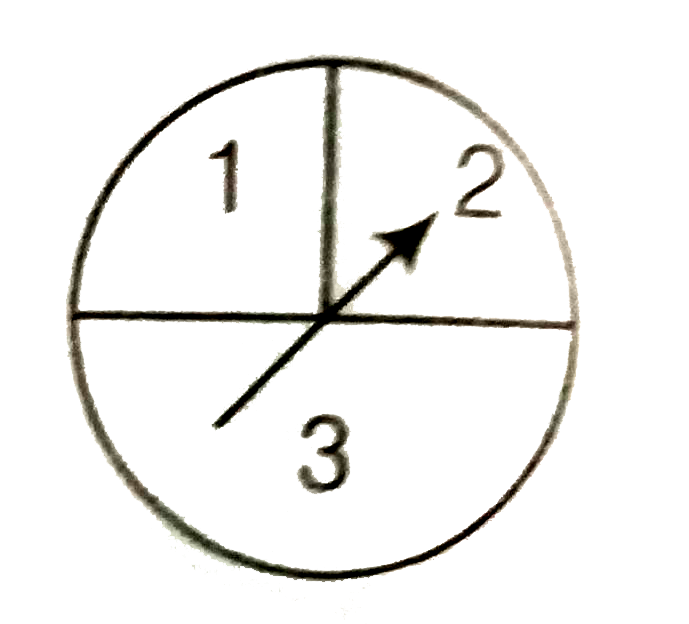A game consists of spining an arrow which comes to rest pointing at one of regions (1,2 or 3) (see figure). Are the outcomes 1,2 and 3 equally likely to occur? Give reason

No, the outcomes are not equally likely, because 3 contains half part of the total region, so it more likely than 1 and 2, since 1 and 2, each contains half part of remaining part of the region.
Topper's Solved these Questions
- STATISTICS AND PROBABILITYBOOK - NCERT EXEMPLAR ENGLISHCHAPTER - STATISTICS AND PROBABILITYEXERCISE - SHORT ANSWERS QUESTIONS
42 Videos
- STATISTICS AND PROBABILITYBOOK - NCERT EXEMPLAR ENGLISHCHAPTER - STATISTICS AND PROBABILITYEXERCISE - LONG ASWERS QUESTIONS
14 Videos
- STATISTICS AND PROBABILITYBOOK - NCERT EXEMPLAR ENGLISHCHAPTER - STATISTICS AND PROBABILITYEXERCISE - LONG ASWERS QUESTIONS
14 Videos
- REAL NUMBERSBOOK - NCERT EXEMPLAR ENGLISHCHAPTER - REAL NUMBERSEXERCISE - LONG ANSWER TYPE QUESTIONS
5 Videos
- SURFACE AREAS AND VOLUMESBOOK - NCERT EXEMPLAR ENGLISHCHAPTER - SURFACE AREAS AND VOLUMESEXERCISE - LONG ANSWER TYPE QUESTIONS
20 Videos
Similar Questions
A game of chance consists of spinning an arrow which comes to rest pointing at one of the numbers 1,2,3,4,5,6,1,8 (see Figure), and these are equally likely outcomes. What is the probability that it will point at(i) 8?(ii) an odd number?(iii) a number greater than 2?(iv) a number less than 9?
View SolutionA game consists of spinning an arrow which comes to rest pointing at one of the numbers 1,2,3,4,5,6,7,8,9,10,11,12. If the outcomes are equally likely, find the probability that the pointer will point at a number between 3 and 11.
View SolutionA game consists of spinning an arrow which comes to rest pointing at one of the numbers 1,2,3,4,5,6,7,8,9,10,11,12. If the outcomes are equally likely, find the probability that the pointer will point at a number less than or equal to 9.
View SolutionA game consists of spinning an arrow which comes to rest pointing at one of the numbers 1,2,3,4,5,6,7,8,9,10,11,12. If the outcomes are equally likely, find the probability that the pointer will point at an even number.
View SolutionA game consists of spinning an arrow which comes to rest pointing at one of the numbers 1,2,3,4,5,6,7,8,9,10,11,12. If the outcomes are equally likely, find the probability that the pointer will point at a prime number.
View SolutionA game of chance consists of spinning an arrow which comes to rest pointing at one of the numbers 1, 2, 3, 4, 5, 6, 7, 8 (See Fig. 131), and these are equally likely outcomes. What is the probability that it will point at (i) 8? (ii) an odd number? (iii) a number greater than 2? (iv) a number less than 9?
View SolutionA game consists of spinning an arrow which comes to rest pointing at one of the numbers 1,2,3,4,5,6,7,8,9,10,11,12, as shown below.

If the outcomes are equally likely, find the probability that the pointer will point at :
(i) a number greater than 8.
View SolutionA game consists fo spining an arrow which come to rest pointing at one of the number 1,2,3,4,5,6,7,8,9, 10,11,12. Find the probability that the point at (i) a prime number, (ii) a number less than or equal to 9, (iii) a number between 3 and 11.
View SolutionA game of change consists of spinning an arrow which is equally likely to come to rest pointing to one of the number, 1, 2, 3, .., 12 as shown in Fig. 13.3. What is the probability that it will point to: (FIGURE) (i) 10? (ii) an odd number?
View SolutionA game of chance consists of spinning an arrow which is equally likely to come to rest pointing to all of the numbers 1, 2, 3, ...,12. What is the probability that it will point to (i) 10 (ii) an odd number (iii) a number which is multiple of 3?
View Solution
